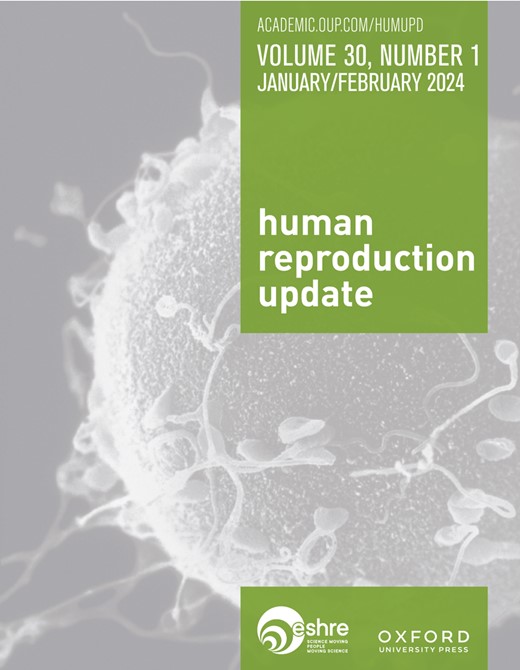Protein O-GlcNAcylation in reproductive biology and the impact of metabolic disease
IF 16.1
1区 医学
Q1 OBSTETRICS & GYNECOLOGY
引用次数: 0
Abstract
BACKGROUND Protein O-GlcNAcylation is a reversible post-translational modification which regulates the function of thousands of proteins to control generic and cell type-specific actions. O-GlcNAc addition and removal downstream of the hexosamine biosynthetic pathway (HBP) is mediated by only two enzymes: O-GlcNAc transferase (OGT) and O-GlcNAcase (OGA), respectively. Crucially, O-GlcNAcylation provides a regulatory layer to protein function that is responsive to metabolic status and thus metabolic disease impinges on this system. Animal and ex vivo models show that O-GlcNAcylation is important for peri-conceptual and pregnancy processes. OBJECTIVE AND RATIONALE Fundamental knowledge about O-GlcNAcylation of proteins involved in reproductive processes is lacking. Here, we give relevant, and mechanistically well understood, examples of how protein O-GlcNAcylation can affect cellular processes and examine available data on germ cells, embryonic development, endometrial receptivity, and placentation. OGT and OGA regulation are placed within the wider context of reproductive biology. We also highlight gaps in knowledge and suggest avenues for next-phase research. SEARCH METHODS PubMed and Google Scholar (2013–2024) were interrogated, including only publications in English. Search terms included: GlcNAc AND Oocyte, GlcNAc AND Sperm, GlcNAc AND Embryo, GlcNAc AND Cell Differentiation, GlcNAc AND Endometrium, GlcNAc AND Endometrial Receptivity, GlcNAc AND Placenta, GlcNAc AND diabetes, and GlcNAc AND obesity. OUTCOMES Some evidence for the global impact of O-GlcNAcylation in maturation of oocytes and sperm, pre-implantation development, implantation, and placentation has been gathered by pharmacological inhibition and/or targeted mutagenesis of OGT and OGA. Blocking or inactivating OGT gives an embryonic lethal phenotype in most species. Mouse embryos can tolerate inactivation of OGA, but the offspring are growth-restricted and die postnatally. In general, HBP utilization in pre-implantation differs between species. This is likely to be the case in post-implantation development too, but it is already clear from stem cell biology that O-GlcNAcylation is important in the differentiation of most embryonic cell lineages including neurones, osteoclasts, enterocytes, and adipocytes. The identification of the progesterone receptor as an OGT target suggests important and widespread involvement of O-GlcNAcylation in reproductive processes. In the adult endometrium, protein O-GlcNAcylation decreases during decidualization, however, there is some evidence to suggest that O-GlcNAcylation of specific proteins promotes receptivity to the implanting embryo. In placenta, key aspects of development (e.g. angiogenesis) and function (e.g. transport, hormone production) are influenced by O-GlcNAcylation. Hyperglycaemia-induced changes in protein O-GlcNAcylation have negative impacts throughout reproductive systems and while there is less information on the consequences of lipid-mediated alterations to this post-translational modification, available evidence points to skewed protein O-GlcNAcylation contributing to impaired reproductive function in individuals living with obesity. WIDER IMPLICATIONS This review highlights protein O-GlcNAcylation as a regulator of reproductive processes and identifies large knowledge gaps which must be filled to improve fundamental understanding. Targeting O-GlcNAcylation regulatory networks, including acceptor site mutagenesis, in defined cell populations of reproductive tissues will advance knowledge. The interface of O-GlcNAcylation with metabolic disease needs disentangling to determine how interventions to alleviate disease impact reproductive outcomes. REGISTRATION NUMBER N/A.蛋白o - glcn酰化在生殖生物学和代谢性疾病中的影响
蛋白质o - glcn酰化是一种可逆的翻译后修饰,它调节数千种蛋白质的功能,以控制一般和细胞类型特异性的行为。在己糖胺生物合成途径(HBP)下游,O-GlcNAc的添加和去除仅由两种酶介导:O-GlcNAc转移酶(OGT)和O-GlcNAcase (OGA)。至关重要的是,o - glcn酰化为蛋白质功能提供了一个调节层,该功能对代谢状态做出反应,因此代谢疾病会影响该系统。动物和离体模型表明,o - glcn酰化对围概念和妊娠过程很重要。目的与原理目前对参与生殖过程的o - glcn酰化蛋白缺乏基本的认识。在这里,我们给出了相关的、机制上很好理解的例子,说明蛋白质o - glcn酰化如何影响细胞过程,并检查了生殖细胞、胚胎发育、子宫内膜容受性和胎盘的现有数据。OGT和OGA调节被置于生殖生物学的更广泛的背景下。我们还强调了知识方面的差距,并提出了下一阶段研究的途径。检索方法检索PubMed和谷歌Scholar(2013-2024),仅包括英文出版物。搜索词包括:GlcNAc与卵母细胞,GlcNAc与精子,GlcNAc与胚胎,GlcNAc与细胞分化,GlcNAc与子宫内膜,GlcNAc与子宫内膜容受性,GlcNAc与胎盘,GlcNAc与糖尿病,以及GlcNAc与肥胖。通过OGT和OGA的药物抑制和/或靶向诱变,已经收集了o - glcn酰化对卵母细胞和精子成熟、着床前发育、着床和胎盘的全球影响的一些证据。在大多数物种中,阻断或灭活OGT会导致胚胎致死表型。小鼠胚胎可以耐受OGA的失活,但其后代生长受限,并在出生后死亡。一般来说,不同物种在着床前对HBP的利用是不同的。这在胚胎植入后的发育过程中可能也是如此,但干细胞生物学已经清楚地表明,o - glcn酰化在大多数胚胎细胞系(包括神经元、破骨细胞、肠细胞和脂肪细胞)的分化中起着重要作用。孕酮受体作为OGT靶点的鉴定表明o - glcn酰化在生殖过程中重要而广泛的参与。在成人子宫内膜中,蛋白o - glcn酰化在去个体化过程中减少,然而,有证据表明特定蛋白的o - glcn酰化促进了着床胚胎的接受性。在胎盘中,发育(如血管生成)和功能(如运输、激素产生)的关键方面受到o - glcn酰化的影响。高血糖诱导的蛋白o - glcn酰化的改变对整个生殖系统都有负面影响,虽然关于脂质介导的这种翻译后修饰改变的后果的信息较少,但现有证据表明,肥胖个体中扭曲的蛋白o - glcn酰化导致生殖功能受损。本综述强调了蛋白o - glcn酰化作为生殖过程的调节因子,并确定了必须填补的巨大知识空白,以提高基本认识。针对o - glcn酰化调节网络,包括受体位点突变,在确定的生殖组织细胞群将推进知识。o - glcn酰化与代谢性疾病的界面需要解开,以确定干预措施如何减轻疾病影响生殖结果。注册号码。
本文章由计算机程序翻译,如有差异,请以英文原文为准。
求助全文
约1分钟内获得全文
求助全文
来源期刊

Human Reproduction Update
医学-妇产科学
CiteScore
28.80
自引率
1.50%
发文量
38
期刊介绍:
Human Reproduction Update is the leading journal in its field, boasting a Journal Impact FactorTM of 13.3 and ranked first in Obstetrics & Gynecology and Reproductive Biology (Source: Journal Citation ReportsTM from Clarivate, 2023). It specializes in publishing comprehensive and systematic review articles covering various aspects of human reproductive physiology and medicine.
The journal prioritizes basic, transitional, and clinical topics related to reproduction, encompassing areas such as andrology, embryology, infertility, gynaecology, pregnancy, reproductive endocrinology, reproductive epidemiology, reproductive genetics, reproductive immunology, and reproductive oncology. Human Reproduction Update is published on behalf of the European Society of Human Reproduction and Embryology (ESHRE), maintaining the highest scientific and editorial standards.
 求助内容:
求助内容: 应助结果提醒方式:
应助结果提醒方式:


